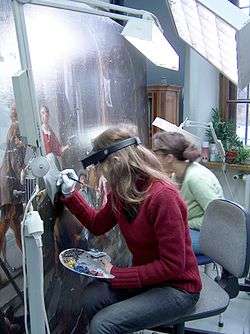Antiques restoration
Antiques restoration is restoring an antique or work of art to a like-new condition, or preserving an antique or work of art against further deterioration as in conservation.
Restoration


Restoration can be as simple as light cleaning to remove disfiguring dirt or grime, such as on the surface of a painting, or it may include near complete rebuilding or replacement, as might be the case with old automobiles or furniture. Often done in preparation for sale, or by a collector upon acquiring a new piece, the main goal of restoration is to "restore" the original appearance or functionality of a piece.
There is a lot of difference between restoring and repairing. Functionality may be achieved by a repair, but restoring an item properly is an art-form. Finishes might/may be stripped and redone, but it is essential that the original patination is retained, if possible. Stripping is only done as a last resort, especially with antique furniture. Engines might be rebuilt with new parts as necessary, or holes in a silver pot might/may be patched. While some of these practices are frowned on by many museums, scholars, and other experts, for many people there is little value in an antique that is unusable or not able to be displayed. Poor restoration is the bane of a trained restorer. Working on someone else's bad repair is the worst possible situation. Often with antique restoration, there are also other issues as well. For example, some collectors value "patina", or also want an item to still reflect an aesthetic that shows its age- in this respect, an "over restored" item can actually take away from its value than if nothing has been done to the item at all. Therefore, restoration of valuable objects should always be left to professionals who are sensitive to all of the issues, ensuring that a piece retains or increases its value after restoration.
Original artwork can sustain all sorts of damage over its lifetime. Conservatorshave an obligation to the artwork to recommend the best techniques for preserving it for future generations.[1]
Restorers are often trained craftspersons, such as furniture makers, mechanics, or metalsmiths. Some have years of experience in their fields, whereas others are self-taught volunteers. Many of the antique aircraft around the United States are restored by trained aircraft engineers assisted by volunteers, some of whom are men who flew those same aircraft years ago.
Given that a single piece of furniture may include wood, glass, inlay, leather and fabric, antique restoration encompasses several skills. Caldararo estimates that 90 percent of USA restorers are self-taught, or cobble together their skills from idiosyncratic backgrounds.[2]
"French Polishing" was the industry standard in Europe during the 18th and 19th centuries, pushed aside by the efficient advantage of modern methods in the Industrial Revolution. Lacquers and spray systems replaced the original French polish finish, which is impractical for mass furniture production due to the labor-intensive process of application. As the desire for antiques was not idle, neither was the need for them to be appropriately restored; thus, the trade has been kept alive by a thread.
Restoration terminology
- Conservation: Detail-oriented process designed to preserve as much original finish and materials as possible while bringing the piece back to as close to its original condition as possible.
- Finish restoration: Finish restoration is the process of bringing an existing finish back to life. This involves re-emulsifying the original finish, either shellac or varnish. By using the original solvents to liquefy the solids, their ability to adhere to and penetrate the piece returns. The process also removes the dirt and grime accumulated over years of use. If the finish is very thin, additional layers of the same finish may be applied to bolster the restored finish and ensure longevity. Finish restoration results in an original finish rating: for example, 85% of the original finish remains. The more original finish that remains, the more antique value remains.
- Preservation: The process of stopping or slowing deterioration usually does not involve actual restoration or attempts to return the piece to its original condition. Damage and finish deterioration are left intact, but prevented from going further. This process is usually done on museum works; we recommend a conservation or restoration process for home use of antiques. In most cases this is a chemical process that prevents further oxidation of the wood and metals, and in addition adds moister to the existing finish.
- Refinishing: Removing a finish and applying a new finish in its place. This process destroys significant portions of antique value in furniture and should be avoided unless absolutely necessary.
- Repair: Physical structural replacement or reinforcement of parts of the original piece. May involve addition of new materials altered to appear aged or the application of antique materials to improve appearance of repair and preserve as much value as possible.
- Restoration: Bringing a piece back to close to its original condition including structural and finish repairs.
- Stripping: stripping involves dipping the piece in a chemical bath that will remove finish, patina, and in some cases the glue holding the piece together.[3]
Salvage
On the other extreme, though most bad old pieces were thrown away long ago, there are pieces that, because of their original design or workmanship or because of damage, are not worth restoring but that are made of re-usable materials such as hard wood, amber, pewter or ivory. As the number of people increases and the number of trees and other natural products in the world decreases, wood and other materials becomes more scarce. So the fact that the material was not worth doing a good job with when an item was made does not mean that the material should be discarded along with the object now.
See also
- Automotive restoration, returning a vehicle to a like-new state, or to an idealization or fantasy of its new state, such as for display at a Concours d'Elegance or for competition in a classic car race
- Building restoration, work performed on a building in an attempt to return it to a previous state
- Conservation-restoration, of a work of art
- Cosmetic restoration, restoration work on a vehicle or building which focuses upon its appearance rather than its functionality or structure
- Fabric restoration, restoration of clothing
- Renovation of vehicles, furniture, appliances, equipment, etc.
- Ship of Theseus
- Vehicle restoration, the process of returning a vehicle to a like-new state
- Watchmaker, one who fixes or restores mechanical watches
References
- ↑ "Paintings and Frames" 2000-2010.
- ↑ Nancy Davis Kho. "Restoring antiques a nearly lost art." San Francisco Chronicle. January 28, 2009.
- ↑ Eric & Stanley Saperstein "The Philosophy of Restoration" December 2002 page 5
- Davis Kho January 28, 2009, Nancy (28 January 2009). "Restoring antiques a nearly lost art". San Francisco Chronicle. Retrieved 30 November 2012.
- "Paintings and Frames". Web design by Sund & Company. Retrieved 10 December 2012.
- Saperstein, Eric & Stanley. "The Philosophy of Restoration" (PDF). Online Horton Brass. Retrieved 10 December 2012.